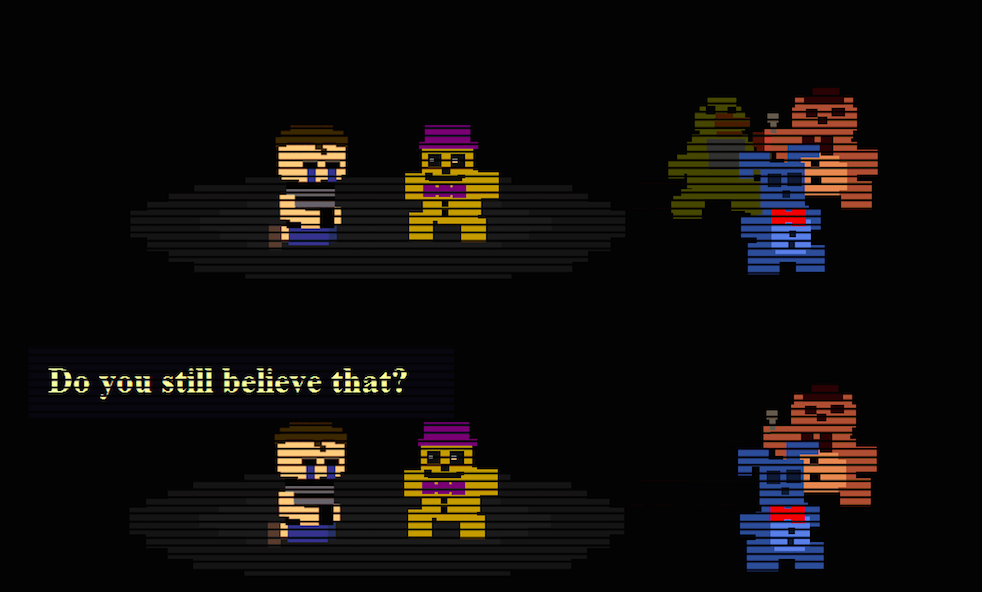I thought it would be nice if the first chapter focuses on the reuniting of the FNaF 1 Animatronics, as well as how life is like in the world of FNaF World. It's crazy, but it's FNaF World. I did promise serious storytelling and that comes in later chapters. I'm still trying to have it. This reminds me of the residual guilt I still feel for not properly updating my list of Five Nights fan games (over 6,000 are now listed on Game Jolt – hey, wait, FNaF World is in there too!). Tagged with free games, Scott Cawthon, Five Nights At Freddy's, Five Nights at Freddy's World.
The Present Perfect Continuous uses two auxiliary verbs together with a main verb.
In this lesson we look at the structure and use of the Present Perfect Continuous tense, as well as the use of for and since, followed by a quiz to check your understanding.
How do we make the Present Perfect Continuous tense?
Fnaf World.com I Am Still Here 2

The structure of the Present Perfect Continuous tense is:
| subject | + | auxiliary have | + | auxiliary be | + | main verb |
| conjugated in Present Simple | past participle | |||||
| have, has | been | present participle |
The first auxiliary (have) is conjugated in the Present Simple: have, has
The second auxiliary (be) is invariable in past participle form: been
The main verb is invariable in present participle form: -ing
For negative sentences we insert not after the first auxiliary verb.
For question sentences, we exchange the subject and first auxiliary verb.

Look at these example sentences with the Present Perfect Continuous tense:
Fnaf World.com I Am Still Here Song
| subject | auxiliary verb | auxiliary verb | main verb | |||
|---|---|---|---|---|---|---|
| + | I | have | been | waiting | for one hour. | |
| + | You | have | been | talking | too much. | |
| - | It | has | not | been | raining. | |
| - | We | have | not | been | playing | football. |
| ? | Have | you | been | seeing | her? | |
| ? | Have | they | been | doing | their homework? |
Contraction with Present Perfect Continuous
When we use the Present Perfect Continuous tense in speaking, we often contract the subject and the first auxiliary verb. We also sometimes do this in informal writing.
| I have been | I've been |
| You have been | You've been |
| He has been She has been It has been John has been The car has been | He's been She's been It's been John's been The car's been |
| We have been | We've been |
| They have been | They've been |
- I've been reading.
- Jenny's been helping us recently.
In negative sentences, we may contract the first auxiliary verb and 'not':
- I haven't been playing tennis.
- It hasn't been snowing.
How do we use the Present Perfect Continuous tense?
This tense is called the Present Perfect Continuous tense. There is usually a connection with the present or now.
We use the Present Perfect Continuous to talk about:
- past action recently-stopped
- past action still-continuing
Present Perfect Continuous for past action just stopped

We use the Present Perfect Continuous tense to talk about action that started in the past and stopped recently. There is usually a result now.
| I'm tired because I've been running. | |||
| past | present | future | |
| |||
| Recent action | Result now | ||
- I'm tired [now] because I've been running.
- Why is the grass wet [now]? Has it been raining?
- You don't understand [now] because you haven't been listening.
Present Perfect Continuous for past action continuing now
We use the Present Perfect Continuous tense to talk about action that started in the past and is continuing now. This is often used with for or since.
| I have been reading for 2 hours. | ||
| past | present | future |
| Action started in past. | Action is continuing now. | |
- I have been reading for 2 hours. (I am still reading now.)
- We've been studying since 9 o'clock. (We're still studying now.)
- How long have you been learning English? (You are still learning now.)
- We have not been smoking. (And we are not smoking now.)
For and Since with Present Perfect Continuous tense
We often use for and since with perfect tenses:
- We use for to talk about a period of time: three hours, two months, one decade
- We use since to talk about a point in past time: 9 o'clock, 1st January, Monday
Fnaf World.com I Am Still Here Download
| for | since |
| a period of time | a point in past time |
| - - - - - - - - - - - - | - • - - - - - - - - - - |
| 30 minutes | 10.00am |
| four days | Friday |
| 3 months | March |
| 2 years | 2010 |
| 3 centuries | 1700 |
| ages | I left school |
| ever | the beginning of time |
| etc | etc |
Fnaf World.com I Am Still Here Game
Look at these example sentences using for and since with the Present Perfect Continuous tense:
- I have been studying for three hours.
- I have been watching TV since 7pm.
- Tara hasn't been feeling well for two weeks.
- Tara hasn't been visiting us since March.
- He has been playing football for a long time.
- He has been living in Bangkok since he left school.